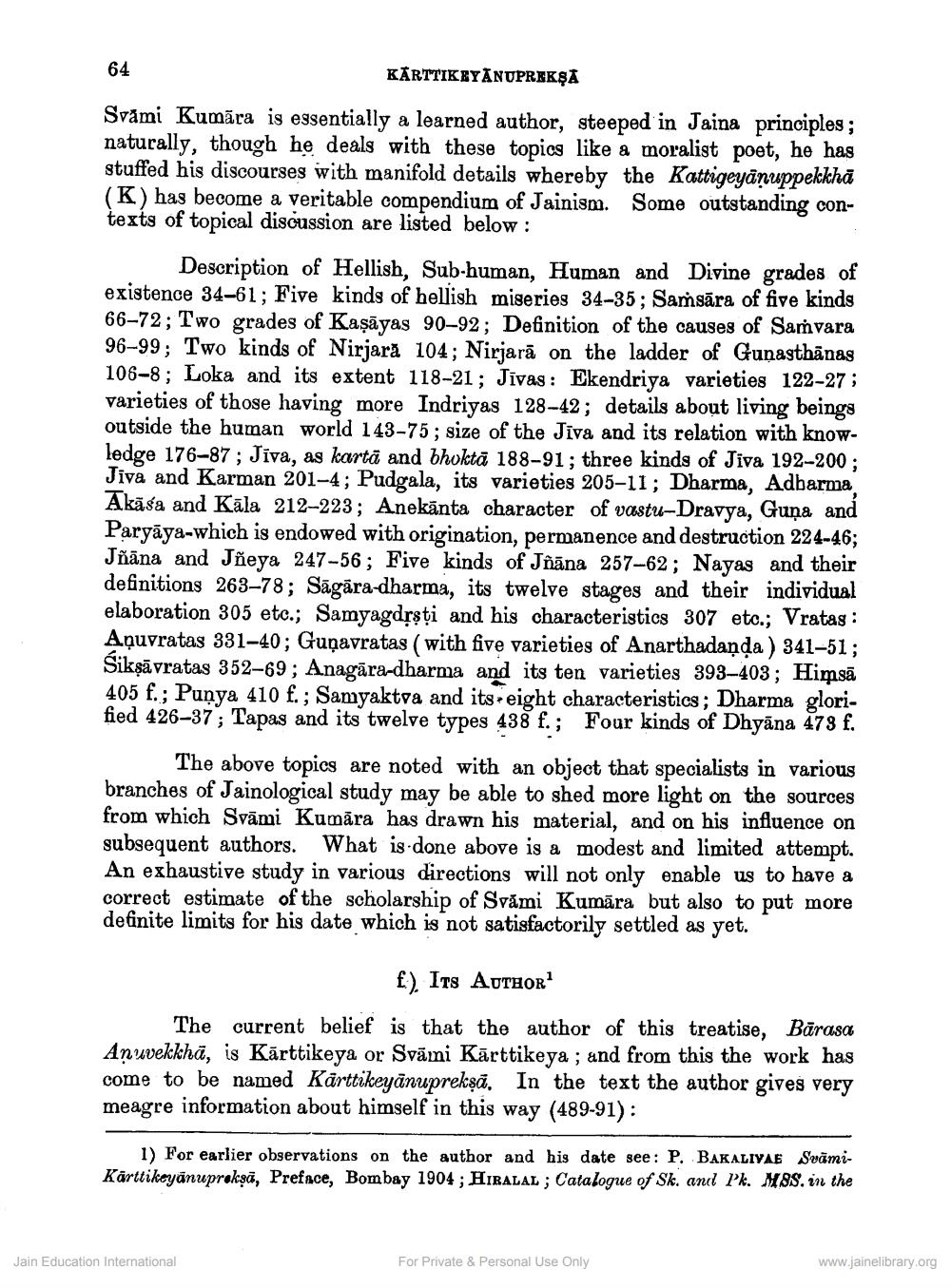________________
64
KÁRTTIKEYANUPREKŞA
Svāmi Kumāra is essentially a learned author, steeped in Jaina principles ; naturally, though he deals with these topics like a moraligt poet, he has stuffed his discourses with manifold details whereby the Kattigeyānuppekkha (K) has become a veritable compendium of Jainism. Some outstanding contexts of topical discussion are listed below:
Description of Hellish, Sub-human, Human and Divine grades of existence 34-61; Five kinds of hellish miseries 34-35; Samsāra of five kinds 66-72; Two grades of Kasāyas 90-92; Definition of the causes of Samvara 96-99; Two kinds of Nirjară 104; Nirjarā on the ladder of Gunasthānas 106-8; Loka and its extent 118-21; Jivas: Ekendriya varieties 122-27 ; varieties of those having more Indriyas 128-42; details about living beings outside the human world 143-75; size of the Jiva and its relation with knowledge 176-87; Jiva, as kartā and bhuktā 188-91; three kinds of Jiva 192-200; Jiva and Karman 201-4; Pudgala, its varieties 205–11; Dharma, Adbarma Akāśa and Kāla 212-223; Anekānta character of vastu-Dravya, Guņa and Paryāya-which is endowed with origination, permanence and destruction 224-46; Jňāna and Jõeya 247-56; Five kinds of Jñana 257-62; Nayas and their definitions 263–78; Sāgāra-dharma, its twelve stages and their individual elaboration 305 etc.; Samyagdrsti and his characteristics 307 etc.; Vratas : Aņuvrataş 331-40; Guņavratas ( with five varieties of Anarthadaņda) 341-51; Sikşāvratas 352-69; Anagāra-dharma and its ten varieties 393-403; Himsā 405 f.; Punya 410 f.; Samyaktra and its eight characteristics ; Dharma glorified 426-37; Tapas and its twelve types 438 f.; Four kinds of Dhyāna 473 f.
The above topics are noted with an object that specialists in various branches of Jainological study may be able to shed more light on the sources from which Svāmi Kumāra has drawn his material, and on his influence on subsequent authors. What is done above is a modest and limited attempt. An exhaustive study in various directions will not only enable us to have a correct estimate of the scholarship of Svămi Kumāra but also to put more definite limits for his date which is not satisfactorily settled as yet.
f). Its Author
The current belief is that the author of this treatise, Bärasa Anuvekkhā, is Kārttikeya or Svāmi Kārttikeya ; and from this the work has come to be named Kärttikeyānupreksā. In the text the author gives very meagre information about himself in this way (489-91):
1) For earlier observations on the author and his date see: P. BAKALIYAE SvāmiKārttikeyānuprokşā, Preface, Bombay 1904 ; HIRALAL; Catalogue of Sk. anul Pk. M88. in the
Jain Education International
For Private & Personal Use Only
www.jainelibrary.org




